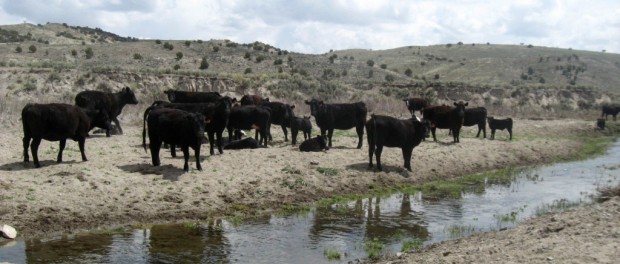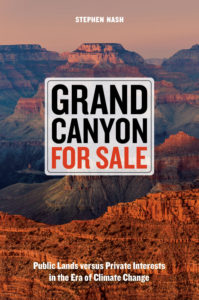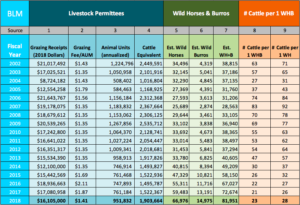Cattle vs. Wild Horses (2002-2018). All data BLM.
Downloadable pdf factsheet included at end of article.
 Photography: Bryce Gray
Photography: Bryce Gray
Who’s overgrazing BLM lands? Subsidized livestock. BLM data shows it.
The below spreadsheet converts grazing receipts reported by the BLM for private livestock grazed under the public lands grazing program, allowing a direct head-to-head comparison between the number of wild horses (WH) estimated by the BLM and permitted cattle grazing from 2002-2018 (see column 9). What does the data show? Cattle historically outnumbering WH by a factor of 71:1 (in 2002), 92:1 (2007) and 28:1 (2018).
This isn’t the story the BLM tells the public. In fact, the BLM doesn’t publicly report subsidized livestock numbers.
It hides them, instead spinning a story of overpopulation and overgrazing by wild horses to justify costly WH roundups, removals, sterilization and sale/euthanasia proposals.
The column 9 ratios prove that justification to be false. And the ratios low-ball how many cattle actually compete with WH for water, forage and land, since grazing fees are calculated according to self-reported rancher AUMs and do not reflect underreporting and trespass grazing (like the more than $1 million that Cliven Bundy owed in back grazing fees in 2014). So the actual number of subsidized, privately owned livestock on public lands is likely much much higher.
Other key findings:

“In this era of American politics, our entire public land heritage is facing the prospect of being put up for sale. I hope this excellent book will awaken all Americans to an unprecedented threat to our parks, national monuments, wilderness areas, wildlife refuges, and ocean sanctuaries.” Bruce Babbitt, Former U.S. Secretary of the Interior
- Beef produced on public lands constitutes just 1.9% of the nation’s beef supply according to Erik Molvar, the director of the environmental group, Western Watersheds Project.
- Public lands ranching subsidizes large livestock operations owned by millionaires and billionaires; less so mom-and-pop ranchers. As reported by New York Times science writer Stephen Nash in his 2017 book, Grand Canyon for Sale, “Some grazing allotments are shared among several permittees; some permittees control several allotments; sometimes it’s just one allotment, one permittee.
That fuzzes up the picture available to us from BLM data, but it tells a hard-edged story, nonetheless. The distribution of this wealth of public land is skewed, to a staggering degree” (p. 137). As Nash spells out:
- About 15,000 individuals and corporate entities hold public-lands grazing permits.
- The top 1% of them — only some 152 permittees — hold interests in an astonishing expanse, about a third of the total BLM grazing land area: some seventy-seven thousand square MILES.
- The next 5 percent of them hold about the next third of the total land area.
- The bottom 94 percent — about 14,000 permittees — account for only the final third of the BLM’s public grazing lands.
The identities of the permittees are sometimes obscured by corporate names, but data provided by the BLM shows that the folks leasing great swaths of public land to graze their cattle and enjoy enormous government subsidies include both people and corporations on Forbes “Billionaires” and “Richest Americans” lists (see p. 138 or click here).
Conclusion:
When advocates claim that livestock outnumbers and out-grazes wild horses on public lands, this is not an emotional argument or an opinion. It is an argument based on the above data from the BLM and other government sources — data that the BLM doesn’t make available to the public and media, because it doesn’t want them to know…about the cattle, their owners, the damage they cause, and the massive subsidies they are taking from average Americans.
Sources for BLM spreadsheet data:
Column (1) BLM budget justification reports. 2018 $ are estimated. 2002-2017 are actual. (2) BLM website (3) calculated by dividing column 1 by column 2, then by 12 (4) multiply column 3 by 2 to account for 1 animal unit = 1 cow and her calf or 1 horse (5-6) BLM website (7) total columns 5+6 (8) column 4 divided by column 7 (9) column 4 divided by column 5. All data compiled by dailypitchfork.org.


Outstanding reporting!
You spell it out clearly and concisely as to the problems the BLM creates and tries to hide. Please email to every member of oversized committee of DOI and Congress.
Thank you!
This is valuable information. Thank you for posting this. I will be reposting for all of my followers on FB and Twitter. So tired of the argument that wild horses and burros are destroying the land when it is obvious that the cattle outnumber them so badly.
The BLM Lies constantly. All you have to do is keep reading, then go to an HMA and watch a roundup where foals, mares and Stalluons get shot in the head because the helicopter pilot said “they (the horse) “didn’t look well”—a pilot; not a vet. There’s SO MUCH CORRUPTION and $$ to be made, each dept of government dealing with this actually ‘covers-up’ for the other. At slaughter these horses fetch between $300.00 to $500.00 a head; multiply that by 80,000 head, which is what the BLM is currently holding in kill pens, and you have a WHOLE LOT OF MONEY GOING STRAIGHT INTO GREEDY and CORRUPT HANDS!!!
Valuable fact checking, we so need people like yourself watching out for the wild horses. Thank you.